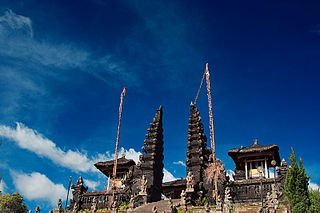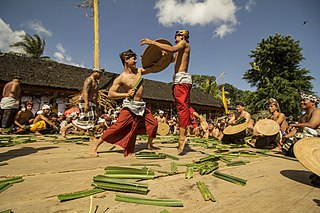Ikat is a dyeing technique from Indonesia used to pattern textiles that employs resist dyeing on the yarns prior to dyeing and weaving the fabric. The term is also used to refer to related and unrelated traditions in other cultures. In Southeast Asia, where it is the most widespread, ikat weaving traditions can be divided into two general clades. The first is found among Daic-speaking peoples. The second, larger group is found among the Austronesian peoples and spread via the Austronesian expansion. Similar dyeing and weaving techniques that developed independently are also present in other regions of the world, including India, Central Asia, Japan, Africa, and the Americas.

Mount Agung is an active volcano in Bali, Indonesia, southeast of Mount Batur volcano, also in Bali. It is the highest point on Bali, and dominates the surrounding area, influencing the climate, especially rainfall patterns. From a distance, the mountain appears to be perfectly conical. From the peak of the mountain, it is possible to see the peak of Mount Rinjani on the nearby island of Lombok, to the east, although both mountains are frequently covered in clouds. Agung is a stratovolcano, with a large and deep crater. Its most recent eruptions occurred from 2017–2019.

The Kintamani or the Kintamani-Bali Dog is a dog native to the Indonesian island of Bali and originated from the Kintamani region. It is a popular pet for the Balinese and locally Bali's only official breed. The breed was developed from free-roaming local Bali street dogs and was recognised by the FCI in 2019.

Bangli Regency is the one and only landlocked regency (kabupaten) of Bali, Indonesia.

Buleleng is a regency of Bali Province, Indonesia. It stretches along the north side of the island of Bali from the Bali Strait in the west almost to the eastern end of the island. It has an area of 1,365.88 km2 and a population of 624,125 at the 2010 census and 791,910 at the 2020 census; the official estimate as of mid-2022 was 825,141. Its regency seat is in the town of Singaraja.

Balinese dance is an ancient dance tradition that is part of the religious and artistic expression among the Balinese people of Bali island, Indonesia. Balinese dance is dynamic, angular, and intensely expressive. Balinese dancers express the stories of dance-drama through bodily gestures including gestures of fingers, hands, head, and eyes.
Gelgel is a village (desa) in the regency (kabupaten) of Klungkung, on Bali, Indonesia. The village, near the coast four kilometers south of the regency capital Semarapura, contains some structures of cultural interest and is known for its pottery and handwoven ceremonial songket cloth.
Kintamani is a district (kecamatan), and a village within that district, on the western edge of the larger caldera wall of the Mount Batur caldera in Bali, Indonesia. It is on the same north–south road as Penelokan and has been used as a stopping place to view the Mount Batur region. Kintamani is also known for Pura Tuluk Biyu's 1,000-year-old "Rites of Peace" stone tablets and the Kintamani dog breed. It is situated next to Mount Batur.
Tenganan Pegringsingan or Pageringsingan is a village in the regency of Karangasem in East Bali, Indonesia. Before the 1970s was known by anthropologists to be a secluded society in the archipelago.

Karangasem Regency is a regency (kabupaten) of the island and province of Bali, Indonesia. It covers the east part of Bali, has an area of 839.54 km2 and had a population of 396,487 at the 2010 Census which rose to 492,402 at the 2020 Census; the official estimate as at mid 2022 was 511,300. Its regency seat is the town of Amlapura. Karangasem was devastated when Mount Agung erupted in 1963, killing 1,900 people. Karangasem was a kingdom before Bali was conquered by the Dutch.

Balinese textiles are reflective of the historical traditions of Bali, Indonesia. Bali has been historically linked to the major courts of Java before the 10th century; and following the defeat of the Majapahit kingdom, many of the Javanese aristocracy fled to Bali and the traditions were continued. Bali therefore may be seen as a repository not only of its own arts but those of Java in the pre-Islamic 15th century. Any attempt to definitively describe Balinese textiles and their use is doomed to be incomplete. The use of textile is a living tradition and so is in constant change. It will also vary from one district to another. For the most part old cloth are not venerated for their age. New is much better. In the tropics cloth rapidly deteriorates and so virtue is generated by replacing them.

Geringsing is a Tenun textile created by the double ikat method in the Bali Aga village of Tenganan Pegeringsingan in Bali. The demanding technique is only practiced in parts of India, Japan and Indonesia. In Indonesia it is confined to the village of Tenganan.

Perang pandan is a Balinese tradition of ritual combat with clubs made of pandan. It is known in the Balinese language as mageret pandan or makare-kare. Perang pandan is practiced by the Bali Aga population of Tenganan village in Karangasem Regency, Indonesia. The people of Tenganan are devotees of the deity Indra. To honour Indra as a warrior god, many major religious festivals in Tenganan involve a ritualistic battle.

The Kingdomship of Bali was a series of Hindu-Buddhist kingdoms that once ruled some parts of the volcanic island of Bali, in Lesser Sunda Islands, Indonesia. With a history of native Balinese kingship spanning from the early 10th to early 20th centuries, Balinese kingdoms demonstrated sophisticated Balinese court culture where native elements of spirit and ancestral reverence combined with Hindu influences—adopted from India through ancient Java intermediary—flourished, enriched and shaped Balinese culture.
The 1976 Bali earthquake occurred at with a surface wave magnitude of 6.5. The shock occurred 5 kilometres (3.1 mi) south of the Bali Sea coast of the Buleleng Regency, and about 65 kilometres (40 mi) northwest of Denpasar. Up to ninety percent of houses in Buleleng Regency were seriously damaged or destroyed and the Seririt sub-district was almost completely destroyed, where a school building collapsed and trapped at least 200 students. 573 people are believed to have died; at least 544 in Buleleng Regency, 24 in Jembrana and 5 in Tabanan. Four thousand more suffered injuries and an estimated 450,000 were left temporarily homeless.
Bali Aga architecture refers to the architecture of the Bali Aga people, the mountain people of Bali, Indonesia. Compared to the lowland Balinese people, the relative isolation of the Bali Aga people meant that they have been less influenced by Hindu-Buddhist traditions. This separate history can be seen in the vernacular architecture of the Bali Aga which shows more similarity with the Austronesian tradition shared with many Indonesian people across the archipelago.

Trunyan or Terunyan is a Balinese village (banjar) located on the eastern shore of Lake Batur, a caldera lake in Bangli Regency, central Bali, Indonesia. The village is one of the most notable homes of the Bali Aga people, the others being the villages of Tenganan and Sambiran. Trunyan is notable for its peculiar treatment of dead bodies, in which they are placed openly on the ground, simply covered with cloth and bamboo canopies, and left to decompose. The influence of a nearby tree is said to remove the putrid smell of the corpses.
Sang Ratu Sri Janasadhu Warmadewa was a king of the Warmadewa dynasty, who ruled Bali around the end of the 10th century CE. Based on various inscriptions, he was the fifth king of the dynasty. King Janasadhu's name has been found in only one inscription, namely the Sembiran inscription, which was dated to 897 Saka.
The Balinese copperplate inscription or Sembiran inscription is a collection of ten copper plate inscriptions, which were found in the village of Sembiran, Tejakula district, Buleleng Regency, on the northern part of Bali island. All inscription plates have a date, which is between 922 and 1181 CE, so they include more than 200 years. Sembiran AI is dated 844 saka, Sembiran B is dated 873 saka, Sembiran A II is dated 897 saka, Sembiran A III is dated 938 saka, Sembiran A IV is dated 987 saka, and Sembiran C is dated 1103 saka. Some of the oldest inscriptions are written in Old Balinese, while some of the later ones are written in Old Javanese.














